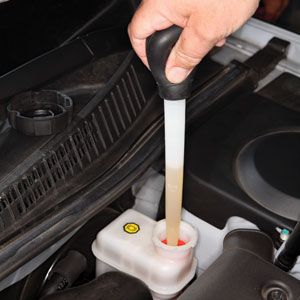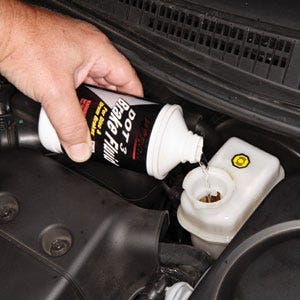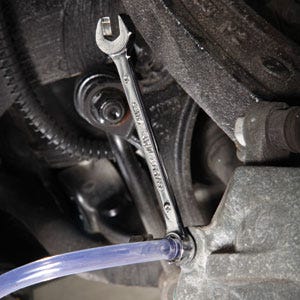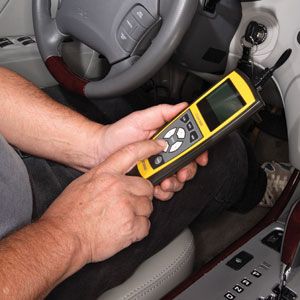Whats the Easiest Way to Bleed the Air Out of a 03 350z
Non even new brake pads tin save you lot from the dreaded soft brake pedal. Peradventure you noticed that you still have to press your brake pedal far into the floorboard to stop even after swapping out your pads. Fresh, thick pads should take brought that pedal back up where it should exist, merely it didn't.
Your pedal probably feels spongy and it's often hard to feel exactly when the brakes start to bite. These are the telltale signs of air in the braking organization, which happens over time with use. It's time to replace that old brake fluid and drain all of the air out of the system.
Why Your Brakes Become Spongy
There are a few different ways air can enter your braking system, and all of them involve brake fluid. Your brakes are a hydraulic system, which means that fluid makes them work. Pressing the restriction pedal shoves brake fluid out to the brakes at the four corners of your automobile. In a disc brake, fluid pushing into the brake caliper is what moves your restriction pads inward to clench down on the rotor and ho-hum the machine using that friction.
Older-style drum brakes work using the same principle, although the chunks of braking compound that wear down in pulsate brakes are in "shoes" instead of "pads." Press the brake pedal down and the brake fluid pushes the shoes outward against the metal drum, thus also using friction to slow the auto. Many cars still use drum brakes in the rear since the front end brakes do almost of the work. (For simplicity'due south sake hither, we'll refer to both shoes and pads every bit a "pad," as they both take the wear material that makes your brakes stop.)
Every bit pads wear down, it takes more fluid to press them onto the braking surface. If yous let your brake pads wear and then thin that the brake fluid level drops too low in the master cylinder reservoir where you fill up the system with fluid, this can introduce some bubbles into the brake lines. Air is much easier to compress than liquid, then bubbles in your brake lines act like a very soft spring in that solid cavalcade of brake fluid between your pes and the brake calipers or drums. Bleeding the brakes will affluent that air out.
While you're bleeding out the air bubbles, it's best to flush all of the erstwhile fluid out of the system and replace information technology with new stuff. Over time, brake fluid becomes contaminated with atmospheric clay and annoying metallic wear particles from moving parts in the restriction cylinders and calipers.
Brake fluid likewise absorbs wet from the air, which can lower its boiling point enough to make it boil at the cease of a long downhill grade or some other scenario such every bit a track day where you're using the brakes repeatedly or for a long time. Just like with a pot on the stove, boiling fluid makes springy air bubbling.
High temperatures as well degrade the alcohol-based fluid itself. Eventually, brake fluid that was relatively articulate when it went in may start to look more like java.
Antilock braking systems are even less tolerant of contaminated fluid and air than systems without ABS. The ABS hydraulic pump operates at several g psi, forcing brake fluid through very small valves. This tin can whip air and brake fluid into a latte-like foam, which makes bleeding air out of the system even more than difficult. Worse still, the ABS pump and valves can easily be damaged by those tiny annoying particles.
Fortunately, air that enters the ABS controller tin be bled out. However, some vehicles require the use of a special ABS scan tool to wheel the pump and valves to purge all the air inside. You tin avoid these ABS problems by regularly remembering to bleed and flush your brake fluid, which is piece of cake enough to exercise at dwelling house.
Permit It Bleed
To properly bleed the brakes, start by acquiring nearly sixteen ounces of fresh brake fluid. An unopened can has a long shelf life, but an opened can should be discarded within a few weeks. Put the vehicle up on jackstands, removing all four wheels.
Next, make sure the bleeder valves can be loosened. You'll demand a box wrench that fits the bleeder bolt, as a crescent wrench or vise-grip could strip off the edges of the bolt and brand it impossible to loosen. It may aid to eject a little penetrating oil on the bolts the twenty-four hours earlier you bleed your brakes, especially if rust is common where y'all live. Loosen these bolts, but leave them closed for now. If they're still not budging later using some penetrating oil, attempt tapping the wrench very lightly with a minor hammer.
If you can't turn the bleeder valves without breaking them off, y'all may need to supercede the brake calipers or wheel cylinders. These are tiny, hollow bolts, then be careful with them! They're easier to break or strip than you lot think.
Next, you'll need a kitchen tool: A small-scale turkey baster. Remove the top of the master cylinder reservoir and suck out as much of the former brake fluid as yous tin. Clean any sediment out of the at present-empty reservoir with a clean, lint-free rag.
Brake fluid is caustic and will destroy the paint and finishes on your car, then remember non to let it drip on your wheels or bodywork. Lay some extra shop towels around where you'll be working with the brake fluid just in example, and wipe off whatever fluid dripped onto a painted surface immediately.
One time the reservoir is clean, get a piece of clear plastic tubing that fits snugly over the terminate of the bleeder bolt. Aquarium tubing is perfect for this, and information technology'due south cheap. Push ane cease of the tube over the brake bleeder bolt at the passenger-side rear corner of the auto (or whichever corner is furthest from the restriction fluid reservoir). Put the other end of the tube into a small, clear bottle with an inch or ii of clean brake fluid in information technology, which will keep air from beingness sucked back into the brake cylinder or caliper.
Put a piece of 1x4 lumber or another spacer under the pedal to prevent it from traveling too far and overextending the brake chief cylinder when the brake system is opened and the line pressure is released. Refill the empty master cylinder reservoir with fresh fluid upwards to its maximum fill line and put the cover dorsum on the reservoir. Fluid can squirt out of an open reservoir every time the pedal is released.
Cue the Helper
Your helper needs to be someone who can follow instructions exactly, just fifty-fifty someone wearing a white apparel could practice this job, as they won't have to crawl around or get dirty at all. Accept your helper sit in the driver's seat and look your orders.
Here's the drill: You say "downwards." Your helper depresses the brake pedal all the way downward with nearly the aforementioned amount of force needed to keep the motorcar from rolling forrard at a traffic light. And so your helper says "down" to ostend just keeps pressing the pedal. Warn your helper that the brake pedal is about to lose pressure and sink to the stop you've put backside it on the floor, merely they must keep pressing it regardless. Then crack the bleeder commodities a quarter-plow.
Some of the old, contaminated fluid will catamenia down the tubing into your bottle, and you'll probably see a few clear bubbles in the line. When the flow stops, shut the bleeder. So you say "up." Your helper says "upwardly" to confirm, and removes their human foot from the pedal.
Repeat this procedure until fresh, clear fluid comes from the bleeder screw with no bubbles in it. Any out-of-sequence moves here can suck air into the caliper. While the stop of the tubing is submerged in fluid, air can still travel past the threads on the bleeder bolt into the caliper if in that location's negative pressure in the system while the bleeder screw is cracked open.
Summit off the restriction fluid reservoir with fresh fluid every six or so pumps. Exercise not allow the reservoir to go more than half empty as air can be sucked into the master cylinder if the fluid level drops too shut to the bottom of the reservoir. Near reservoirs have a "Minimum" line for this reason, so if yours has one, watch and make certain that your restriction fluid never dips beneath that line.
One time clean fluid is coming through the tubing, tighten the bleeder bolt and move your operation to the left rear brake. In that location, outset doing the aforementioned routine with your helper all once more until clean, bubble-free fluid comes out of your tube. Echo the process with the right front brake and finally with the left front brake. The idea is to work from the calipers farthest away from your restriction fluid reservoir inward to get the gross fluid in the furthest reaches of the organisation out first.
Yous may want to double-check your work by going back around to each caliper in the order that y'all flushed them, reattaching the tube and giving the system a few pumps to ensure that a solid stream of make clean fluid comes out. Shut the bleeder screw once you lot're washed with each corner and make sure you're nonetheless topping off the brake fluid reservoir equally you go.
Finally, fill the restriction fluid reservoir to its maximum fill line, put the wheels back on the auto and go for a drive to make sure that stock-still the issue.
Air Sabbatical
For an older vehicle without an antilock braking system, this process volition practice a corking task even if y'all introduced extra air in the organization subsequently replacing a caliper or brake cylinder. This fifty-fifty gets most of the big bubbles out of a newer system with ABS. However, if there's still some sponginess on those ABS-equipped brakes, yous may want to bleed the ABS controller itself.
You'll need to consult your car's service manual to find the appropriate manner to drain your car's antilock braking system. There may be a bleeder bolt correct on the ABS controller, or you may need to beg, borrow or steal an ABS-capable scan tool.
This content is created and maintained past a tertiary party, and imported onto this page to help users provide their email addresses. You may be able to find more than information about this and similar content at piano.io
Source: https://www.popularmechanics.com/cars/how-to/a1495/how-to-bleed-brakes/






0 Response to "Whats the Easiest Way to Bleed the Air Out of a 03 350z"
Post a Comment